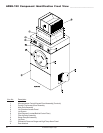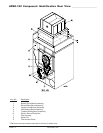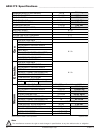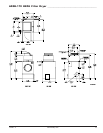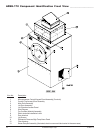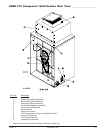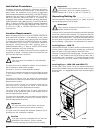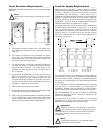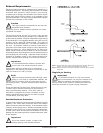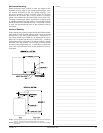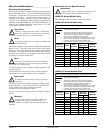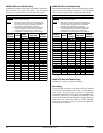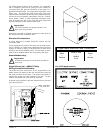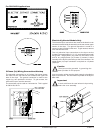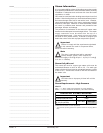
18 American Dryer Corp. 113247-3
Exhaust Requirements ________________
Exhaust ductwork should be designed and installed by a
qualified professional. Improperly sized ductwork will create
excessive back pressure, which results in slow drying,
increased use of energy, and shutdown of the burner by the
airflow (sail) switch, burner hi-limits, or lint chamber hi-limit
protector thermostat. The dryer must be installed with a proper
exhaust duct connection to the outside.
Caution
This dryer produces combustible lint and must be
exhausted to the outdoors.
Improperly sized or installed exhaust ductwork can create
a potential fire hazard.
The ductwork should be laid out in such a way that the
ductwork travels as directly as possible to the outdoors with
as few turns as possible. Single or independent dryer venting
is recommended. It is suggested that the use of 90° turns be
avoided; use 30° and/or 45° bends instead. The radius of
the elbows should preferably be 1-1/2 times the diameter of
the duct. All ductwork should be smooth inside with no
projections from sheet metal screws or other obstructions,
which will collect lint. When adding ducts, the duct to be
added should overlap the duct to which it is to be connected.
All ductwork joints must be taped to prevent moisture and lint
from escaping into the building. Inspection doors should be
installed at strategic points in the exhaust ductwork for
periodic inspection and cleaning of lint from the ductwork.
Important
It is recommended that exhaust or booster fans
not be used in the exhaust ductwork system.
Exhaust back pressure measured by a manometer/
magnehelic in the exhaust duct must be no less than 0 and
must not exceed 0.3 in WC (0.74 mb).
Note
When the exhaust ductwork passes through a wall,
ceiling, or roof made of combustible materials, the
opening must be 2-inches (5.08 cm) larger than the duct
(all the way around). The duct must be centered within this
opening.
As per the National Fuel Gas Code, “Exhaust ducts for type
2 clothes dryers shall be constructed of sheet metal or
other noncombustible material. Such ducts shall be
equivalent in strength and corrosion resistance to ducts
made of galvanized sheet steel not less than 26 gauge
(0.0195-inches [0.50 mm]) thick.”
Outside Ductwork Protection
To protect the outside end of the horizontal ductwork from the
weather, a 90° elbow bent downward should be installed
where the exhaust exits the building. If the ductwork travels
vertically up through the roof, it should be protected from the
weather by using a 180° turn to point the opening downward.
In either case, allow at least twice the diameter of the duct
between the duct opening and the nearest obstruction (refer
to the diagram).
Impor tant
Do not use screens, louvers, or caps on the
outside opening of the exhaust ductwork.
NOTE 1 Opening must be 2-inches (5.08 cm) larger than the duct (all the way
around). The duct must be centered within this opening.
NOTE 2 Distance should be 2 times the diameter of the duct to the nearest
obstruction.
Single Dryer Venting
Important
For extended ductwork runs, the cross section
area of the ductwork can only be increased to an
extent. When the ductwork approaches the maximum
limits as noted in this manual, a professional HVAC firm
should be consulted for proper venting information.
!
!
!
!
!



